This blog post provides a collection of 10 exciting epoxy resin art projects with step-by-step tutorials to inspire your creativity. Whether you are a seasoned resin artist or a beginner, these tutorials offer a range of projects, from simple coasters to intricate wall art, to suit your skill level. The post covers a variety of techniques, including creating geode coasters, serving boards, bookends, ornaments, and keychains. Each tutorial includes a comprehensive list of materials and detailed instructions, making it easy for you to get started. Whether you are looking to create stunning home decor pieces or unique gifts, this blog post is sure to inspire and guide you through the process.
Epoxy Resin Art Projects
Epoxy resin is a versatile material that has taken the art world by storm. It offers a crystal clear, glossy finish that can be used to create stunning pieces of art. Whether you’re a seasoned artist or just starting out, here are ten epoxy resin art projects that you can try at home.
Resin River Tables: Create stunning, one-of-a-kind tables by pouring resin into wood grain to create the illusion of a flowing river.
Resin Coasters: Mix resin with alcohol ink to create colorful, abstract coasters for your home.
Resin Geode Coasters: Use resin to mimic the natural beauty of geodes by adding glitter, stones, and other materials to the mix.
Resin Wall Art: Pour resin into a canvas or other surface to create a unique piece of wall art.
Resin Jewelry: Use resin to create pendants, earrings, and other jewelry pieces that are both beautiful and functional.
Resin Cheese Boards: Transform a simple wooden board into a work of art by pouring resin and adding natural materials like herbs and flowers.
Resin Serving Trays: Create a resin serving tray that doubles as a work of art by adding pigments, glitter, and other embellishments.
Resin Bookends: Use resin to create custom bookends that will add a touch of style to your bookshelf.
Resin Ornaments: Create resin ornaments for the holidays or special events by adding glitter, paint, and other materials.
Resin Keychains: Personalize your keys with resin keychains that you create yourself by mixing resin with mica powder, glitter, or other materials.
Each of these epoxy resin art projects can be adapted to your own personal style and taste. Get creative, have fun, and let your imagination run wild. With a little bit of patience and a lot of hard work, you’ll be amazed at the beautiful pieces you can create with epoxy resin.
A Quick Note on Safety Precautions for Resin Art Projects
Epoxy resin is a chemical and can be harmful to humans if handled irresponsibly.
The beauty of epoxy resin art makes it easy to forget the dangers associated with creating it. Forget about all the beautiful trinkets, sparkling coasters, and brilliantly shining countertops for a few minutes.
When working with epoxy resin you mix chemicals, inhale fumes, and risk contact with your bare skin. Industrial chemicals, like epoxy resin, have the potential to severely injure you if not used responsibly.
Although it is easy to leave your rose-colored glasses on, please take them off for a moment to familiarize yourself with the risks associated with epoxy resin.
In sum, epoxy resin is not as harmless as many believe.
Let us familiarize you with the potential dangers of working with epoxy resin and, more importantly, teach you how to best protect yourself from these risks.
Check out Is Epoxy Resin Hazardous to Your Health? to become an expert on Epoxy Resin and how to protect yourself from any negative health affects you may experience.
We do not want to scare you aware from working with epoxy resin. In fact, many companies have done a tremendous job limiting the VOCs and other harmful components in their craft resins. However, we think being prepared is the best line of defense to running into unwanted issues down the line. Epoxy resin is safe to use when used responsibly and by those willing to learn how to protect themselves. If this is you, happy crafting!
Resin Art Project 1: Resin River Table

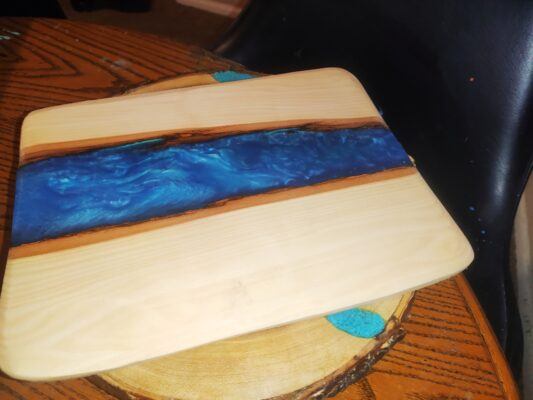
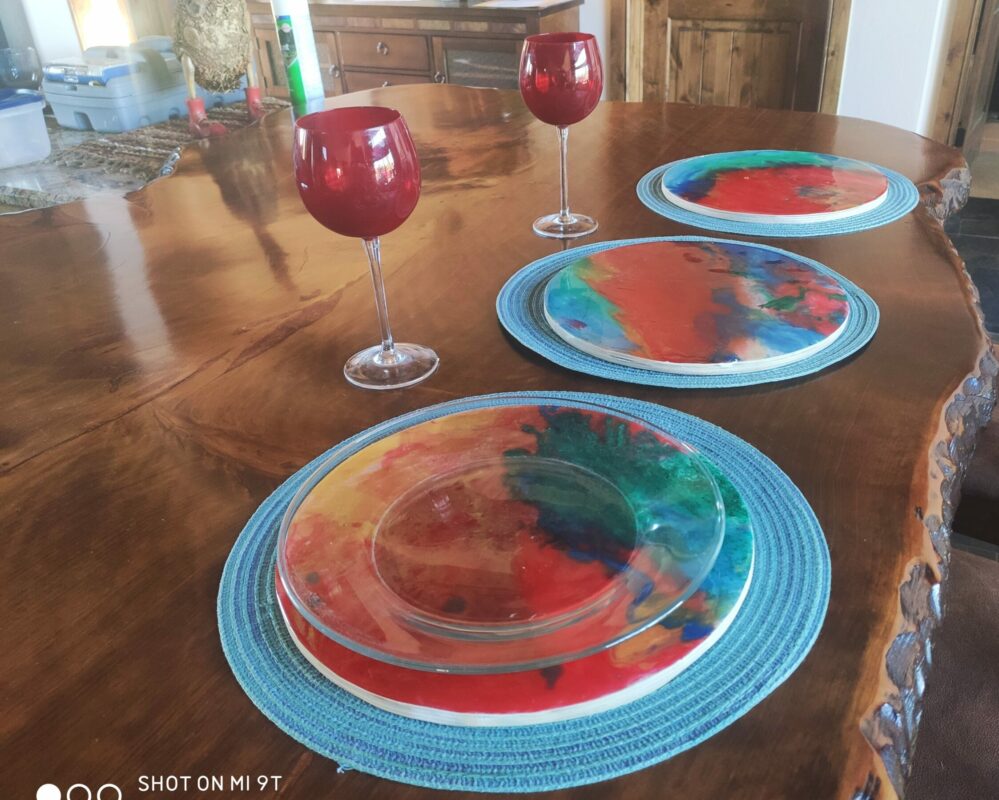
A resin river table is a beautiful and unique piece of furniture that can be made at home with a few supplies and a little bit of patience.
Resin River Table Material List
- Deep Pour Epoxy Resin
- Wood Slabs
- Resin Table Mold
- Pigment (for Opaque River) or Dye (for Translucent River)
- Mold Release
- Measuring/Mixing Cups
- Mixing sticks
- Gloves
- Table Hardware (Choose your favorite hardware to create your own masterpiece resin river table.)
- Sandpaper
Resin River Table Tutorial
Step 1: Prepare the Wood Board
Choose two pieces of wood or cut a wood slab into two pieces lengthwise. Sand both pieces down to remove any rough spots. Clean the surfaces thoroughly to remove any sawdust or debris.
Step 2: Create your Mold
Each of the molds linked in the material list above are extremely handy for making resin river table. I have provided a mold I recommend for square, rectangular and circle resin table pours. If you need to make a custom sized table, you can make your own with a bit of knowledge about materials epoxy resin does not stick to. Fortunately, we have put together the most inclusive guide to learning this very thing. Chek out What Epoxy Resin Sticks To and Does Not Stick To to learn how to construct your own custom size mold for this project. If you are satisfied with on of the sizes offered in the molds recommended above, this step is complete. I do suggest spraying a bit of mold release into the mold.
Step 3: Create the River
Place your slabs on either side of the PVC mold, being sure that the wood is snug against the sides of the mold. You can use hot glue to stick the word pieces to your mold if you are worried they will float once the epoxy is added. However, it works just as well to place a heavy object onto both wood slabs before pouring the resin into the middle. This will prevent the wood from floating and resin from seeping underneath the slabs.
Step 4: Mix the Resin
Measure out the required amount of resin and hardener, according to the manufacturer’s instructions. Mix the two components together thoroughly using a mixing stick in a disposable cup or container. If desired, add a few drops or dye or a tiny scoop of pigment to the resin mixture to create a color.
Step 5: Pour the Resin
Slowly pour the resin mixture into the middle of the slabs. Be sure to pour from at least 6 inches above the mold to avoid air bubbles in your cured resin piece. Pour about half way and use a mixing stick to spread the resin over the entire river area. Use a torch or heat gun to lightly move over the resin surface to pop any air bubbles. Continue to pour the resin mixture into the river area until the resin has reached the top of the wood slabs. (It is okay if the resin overflows over the top of the slabs a bit, as you will be able to sand down the excess in one of the following steps.) Use your heat gun or torch one more time to pop any remaing air bubbles.
Step 6: Spread the Resin
Continue spreading the resin mixture until it is level and covers the entire taped-off area. Tap the sides of the board gently to release any air bubbles.
Step 7: Curing the Resin
Let the resin cure completely, following the manufacturer’s recommended curing time. Cover the mold with a box to protect it from dust and debris.
Step 9: Finish and Seal
Once the resin has cured, demold your table. Sand down the surface of the table to remove any rough spots and to ensure the epoxy resin and wood is siting level on both sides. Apply a clear coat of resin over the entire surface to seal and protect it.
Step 9: Add Table Hardware
Add the table hardware you have selected to the bottom your table following the instructions included with the hardware.
Step 10: Enjoy
Your resin river table is now ready to use! Display it in your home or office for a stunning and unique piece of furniture.
Note: Be sure to follow all safety precautions when working with epoxy resin, including wearing gloves and protective eye wear. Work in a well-ventilated area and follow the manufacturer’s instructions carefully.
Resin Art Project 2: Resin Coasters
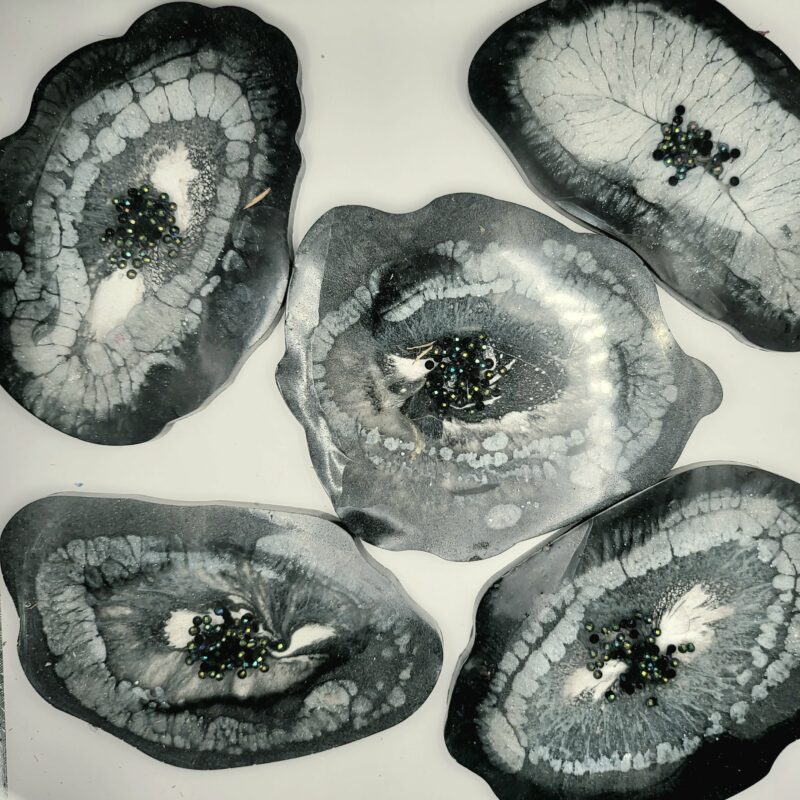
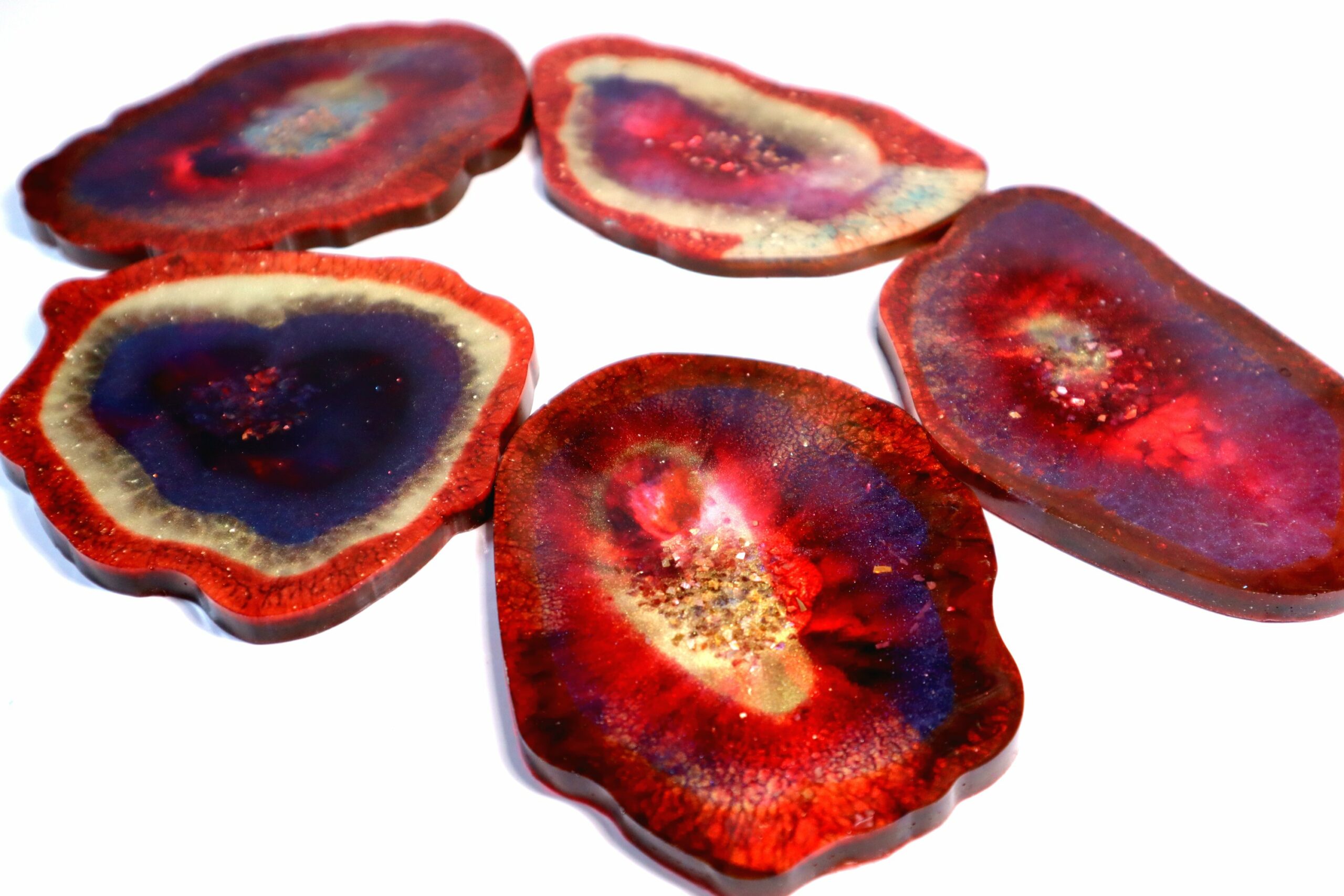
Resin Coasters Material List
Here is a basic list of materials you will need to make resin coasters:
- Craft Resin Epoxy Resin
- Measuring cups
- Mixing sticks
- Gloves
- Silicone Coaster Molds
- Colorants (optional)
- Glitter or other embeddables (optional)
- Sandpaper (Optional)
- Metallic Paint Marker
Resin Coasters Tutorial
Making resin coasters involves the following basic steps:
Step 1: Gather materials
You will need resin, hardener, measuring cups, stir sticks, gloves, silicone molds for coasters, and any additional materials such as colorants, glitter, or embeddable objects
Step 2: Mix The Resin
Follow the manufacturer’s instructions to measure and mix the resin and hardener. Mix thoroughly to ensure an even consistency.
Step 3: Add Colorants and/or Embeddables
If desired, add colorants or embeddables to the resin mixture and stir.
Step 4: Pour the Resin
Pour the resin mixture into the silicone molds, making sure to not overfill the molds. Tap the molds gently to remove any air bubbles. Experiment with designs by using pigments of different weight. For instance, pigment powders are heavier than resin dyes, so when resin colored with pigment powders is poured over resin colored with dye, it creates beautiful effects, sometimes like a webbing or scale like design, in the resin coasters.
Watch the tutorials linked below to learn how to emulate some of the most beautiful resin coaster techniques used today!
Step 5: Curing and Demolding Coasters
Allow the resin to cure for the recommended time. You can usually demold Craft Resin (the resin I recommend for this type of project that I have linked above) after 12 hours. The resin will not be cured to a solid yet but you will be able to take the coasters out of the molds to see your beautiful creations!
Step 6: Finish with Metallic Edge (Optional)
Using the metallic paint marker recommended in the material list above, trace around the edges of your coaster for a metallic edge. The recommended paint markers, by DecoColor, are perfect for the task because they do not rub off your resin coasters once dry and are highly pigmented, leaving a mirror-like shine finish.
Step 7: Add a Top Coat (Optional)
If needed, sand the surface of the coasters with a medium grit sand paper/ Brush off any dust and debris / Pour a thin top coast of clear epoxy resin over the surface of your coasters for a shinier finish.
Tip: Place each coaster on a small dixie cup before pouring your topcoat of resin. This ensures your topcoat does not spill over the edges, changing the shape of your coasters. Instead, any resin that rolls over the edge drips onto the table top surface. (which surely you have already protected with a silicone or plastic mat!)
Note: Always follow the manufacturer’s instructions and safety precautions when working with resin.
Resin Coasters Video Tutorials
Check out Budget Resin Coasters Tutorial
See also, 3D Flower Resin Coasters Tutorial
Resin Art Project 3: Resin Geode Coasters
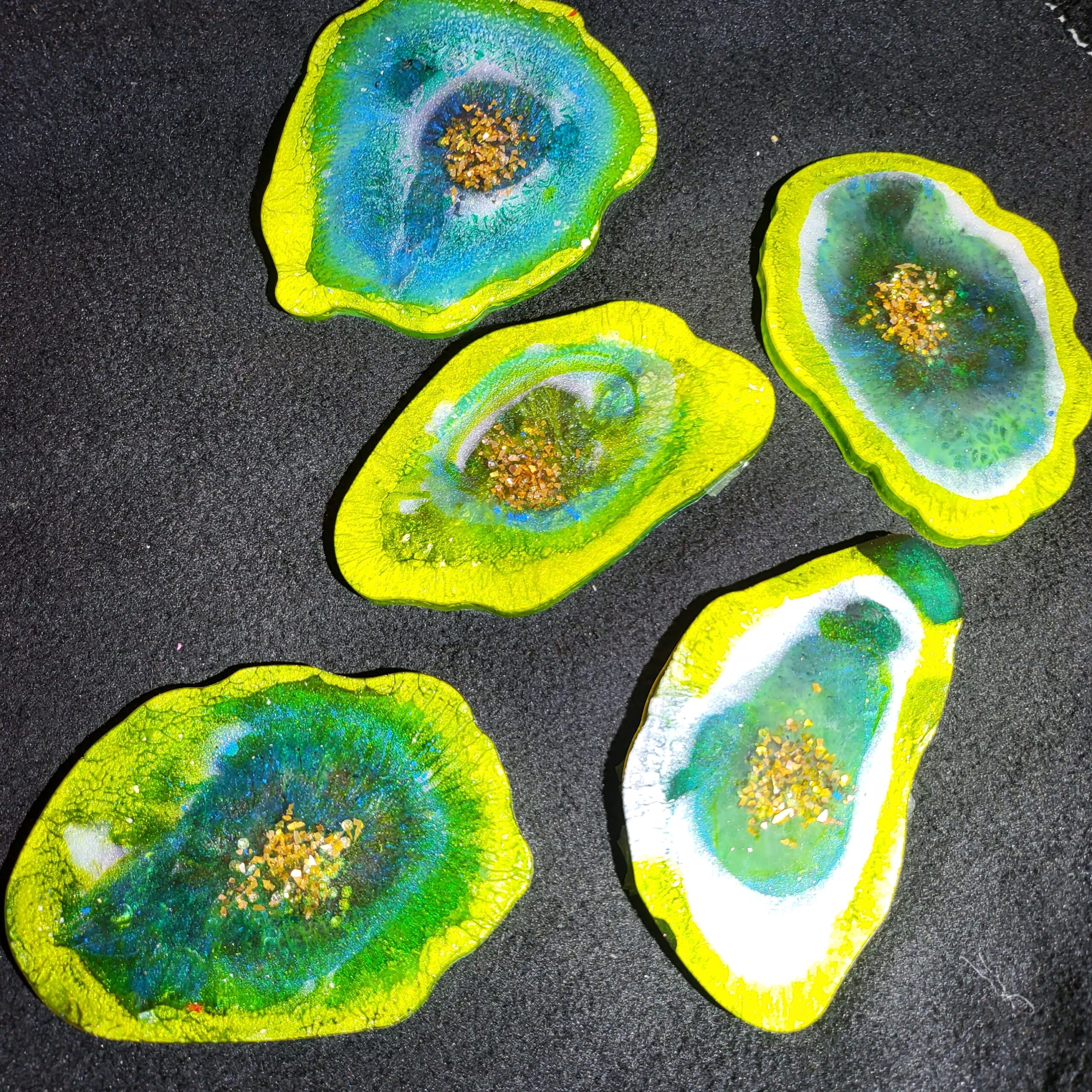

Resin Geode Coaster Material List
Here is a list of materials you will need to make resin geode coasters:
- Craft Resin Epoxy Resin
- Measuring cups
- Mixing sticks
- Gloves
- Silicone Coaster Molds
- Colorants (optional)
- Glitter or other embeddables (optional)
- Sandpaper (Optional)
- Metallic Paint Marker
Resin Geode Coaster Tutorial
Making resin geode coasters involves the following steps:
Step 1: Gather materials
You will need resin, hardener, measuring cups, stir sticks, gloves, silicone molds for coasters, and any additional materials such as colorants, glitter, or embeddable objects
Step 2: Mix The Resin
Follow the manufacturer’s instructions to measure and mix the resin and hardener. Mix thoroughly to ensure an even consistency.
Step 3: Add Colorants and/or Embeddables
If desired, add colorants or embeddables to the resin mixture and stir.
Step 4: Pour the Resin
Pour the resin mixture into the silicone molds, making sure to not overfill the molds. Tap the molds gently to remove any air bubbles. Experiment with designs by using pigments of different weight. For instance, pigment powders are heavier than resin dyes, so when resin colored with pigment powders is poured over resin colored with dye, it creates beautiful effects, sometimes like a webbing or scale like design, in the resin coasters.
Watch the tutorials linked below to learn how to emulate some of the most beautiful resin coaster techniques used today!
Step 5: Curing and Demolding Coasters
Allow the resin to cure for the recommended time. You can usually demold Craft Resin (the resin I recommend for this type of project that I have linked above) after 12 hours. The resin will not be cured to a solid yet but you will be able to take the coasters out of the molds to see your beautiful creations!
Step 6: Finish with Metallic Edge (Optional)
Using the metallic paint marker recommended in the material list above, trace around the edges of your coaster for a metallic edge. The recommended paint markers, by DecoColor, are perfect for the task because they do not rub off your resin coasters once dry and are highly pigmented, leaving a mirror-like shine finish.
Step 7: Add a Top Coat (Optional)
If needed, sand the surface of the coasters with a medium grit sand paper/ Brush off any dust and debris / Pour a thin top coast of clear epoxy resin over the surface of your coasters for a shinier finish.
Tip: Place each coaster on a small dixie cup before pouring your topcoat of resin. This ensures your topcoat does not spill over the edges, changing the shape of your coasters. Instead, any resin that rolls over the edge drips onto the table top surface. (which surely you have already protected with a silicone or plastic mat!)
Note: Always follow the manufacturer’s instructions and safety precautions when working with resin.
Resin Geode Coasters Video Tutorials
These are one of my all-time favorite projects to make, as you can see by all the resin geode coasters available in my resin art shop.
As a result, I have many video tutorials for this technique. I will list a few here if you ae interested or need some inspiration!
Resin Art Project 4: Resin Wall Art
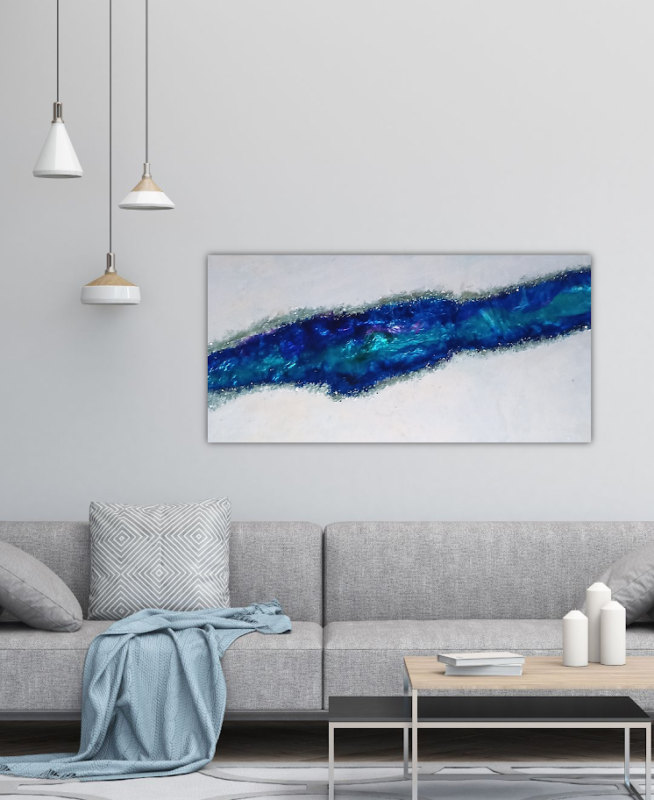

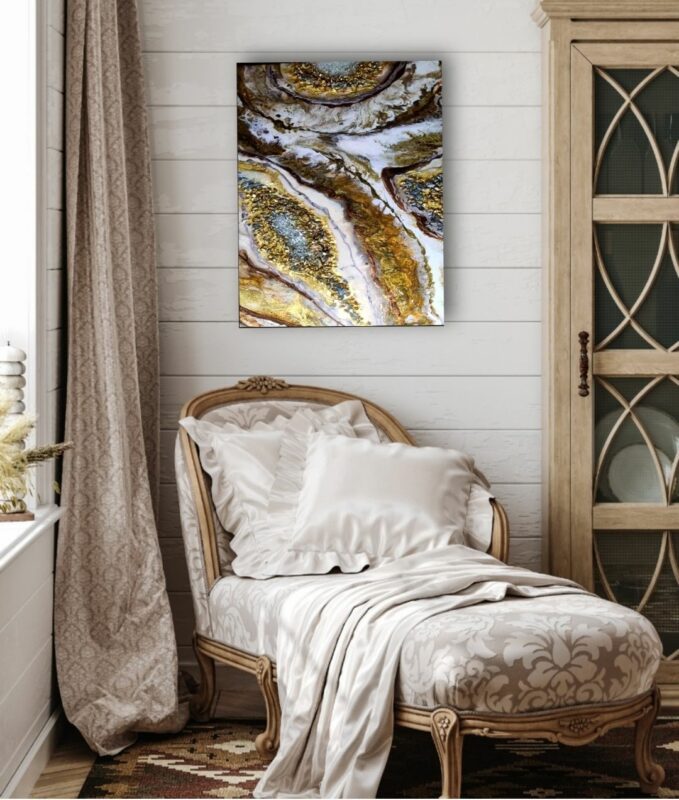

Resin Wall Art Material List
Here is a list of materials you will need to make resin wall art:
- Craft Resin Epoxy Resin
- Measuring cups
- Mixing sticks
- Gloves
- Level or Leveling Plate
- Surface Protection
- Canvas
- Painters’ Tape
- Primer
- Colorants (optional)
- Glitter or other embeddables (optional)
- Heat Gun or Torch
Resin Wall Art Tutorial
Making resin wall art involves the following steps:
Step 1: Gather materials
You will need resin, a hardener, a large mixing container, stir sticks, gloves, a flat surface for pouring the resin (such as a disposable plastic tablecloth or a silicone mat), a canvas or other surface to pour the resin onto, colorants, and any additional materials such as glitter, mica powder, or embeddables.
Step 2: Prepare Canvas
Apply a sealant or resin primer to your canvas to prevent the resin from soaking into the surface. For this, I suggest using Gesso to prime your canvas. The Gesso product I use to seal my canvases before a resin pour is linked in the material list above.
If you want clean edges, tape the edges of the canvas with painter’s tape before you pour your resin. Some prefer to have resin drips on the edge of their canvas. Either technique is fine. it is all personal preference.
Step 3: Mix the Resin
Follow the manufacturer’s instructions to measure and mix the resin and hardener. Mix thoroughly to ensure an even consistency.
Step 4: Add Colorants, Glitters, and/or Embellishments
Separate the resin into a few different cups. Add your chosen colors and/or glitters/embedables into each of the cups and mix.
Step 5: Pour the Resin
Pour each of your colored resins onto the canvas in whatever pattern you would like. Be sure to cover the entire surface.
Tip: Experiment with using clear resin underneath or on top of the colored resin. You may also choose to spray some silicone oil onto the resin to create the resin ‘cells’ seen in many resin wall art pieces today.
Step 6: Pop Bubbles
Use a heat gun or torch to lightly run across the surface of your resin-covered canvas. This will pop any air bubbles in your epoxy resin.
Step 7: Let Resin Cure
Allow the resin to cure for the recommended time, usually 24 to 48 hours, depending on the type of resin used.
Step 8: Peel Off Tape
If you have taped off your canvas edges, be sure to peel the tape off before your resin has cured completely. For Craft Resin, you should peel your tape off between the 8-12 hour curing mark. The tape peels easily when the resin is about halfway cured.
If you wait too long, it may be a bit harder to pull the tape off. If you have trouble peeling it off, use your heat gun to heat the tape up a bit and it should come off easily.
Note: Always follow the manufacturer’s instructions and safety precautions when working with resin.
Resin Wall Art Video Tutorials
Check out Epoxy Resin and Foil Wall Art Technique
See also, Ultimate Ocean Resin Wall Art Tutorial
Here is another great beginner’s tutorial: Beginner’s Resin Wall Art Tutorial
Resin Art Project 5: Resin Jewelry

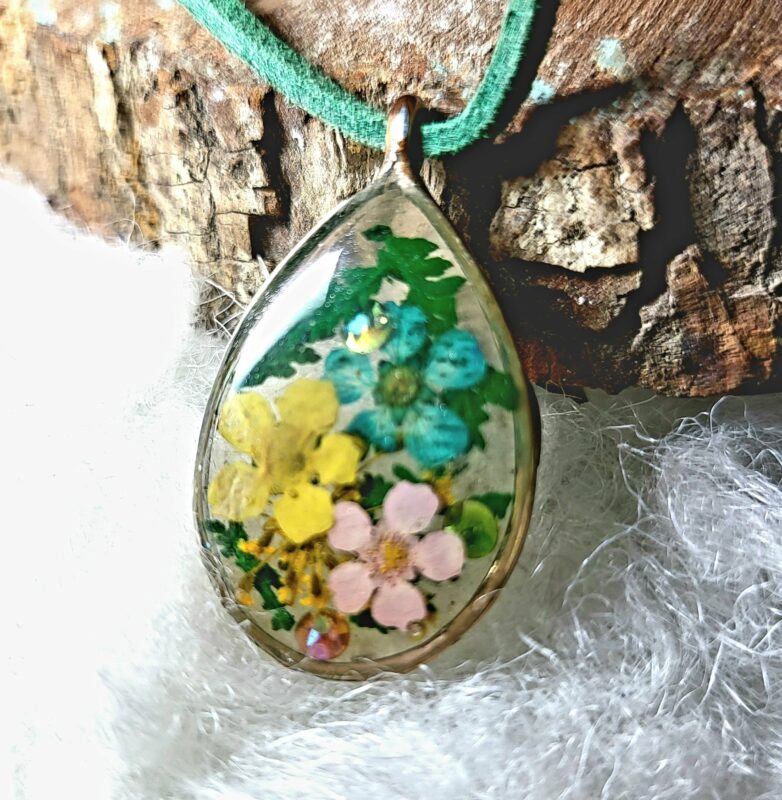
Resin Jewelry Material List
Here is a list of materials you will need to make resin jewelry:
- Craft Resin Epoxy Resin
- Measuring cups
- Mixing sticks
- Gloves
- Jewelry Molds or Bezels
- Colorants (optional)
- Glitter or other Embeddables (optional)
- Findings
- Handheld Jewelry Drill
- Jewelry Plier Set
Resin Jewelry Tutorial
Step 1: Gather materials
Gather all of the materials listed above, as well as any additional tools you may need, such as pliers for attaching jump rings or hooks.
Step 2: Mix the Resin
Follow the manufacturer’s instructions to measure and mix the resin and hardener. Mix thoroughly to ensure an even consistency.
Step 3: Add Colorant to Resin
Split resin into multiple cups. Add colorants to each resin cup and stir.
Step 4: Pour Resin Into Molds
Pour the resin mixture into the jewelry molds or bezels, making sure to fill any gaps.
Step 5: Add Embeddables
If desired, sprinkle glitter or other embeddables into the resin mixture. Popular embeddables for resin jewelry are sprinkles, dried flowers, dried leaves, newspaper clippings, and pictures. Remember, with resin art the possibilities are endless, so get creative and make something no one has ever seen before!
Step 6: Allow Resin to Cure
Allow the resin to cure for the recommended time, usually 24 to 48 hours, depending on the type of resin used.
Step 7: Demold
After cured, demold your resin jewelry pieces.
Step 8: Drill Hole and Add Findings
Using a handheld jewelry drill or a Dremel, drill a hole into the top of your jewelry pieces. (If you are making a bracelet, drill one hole on either side of the piece.) Add findings to your jewelry piece and you are finished!
Resin Jewelry Video Tutorials
Check out Resin Jewelry Using UV Resin Tutorial
See also, Resin Nature Ring Tutorial
Resin Art Project 6: Resin Cheese Board

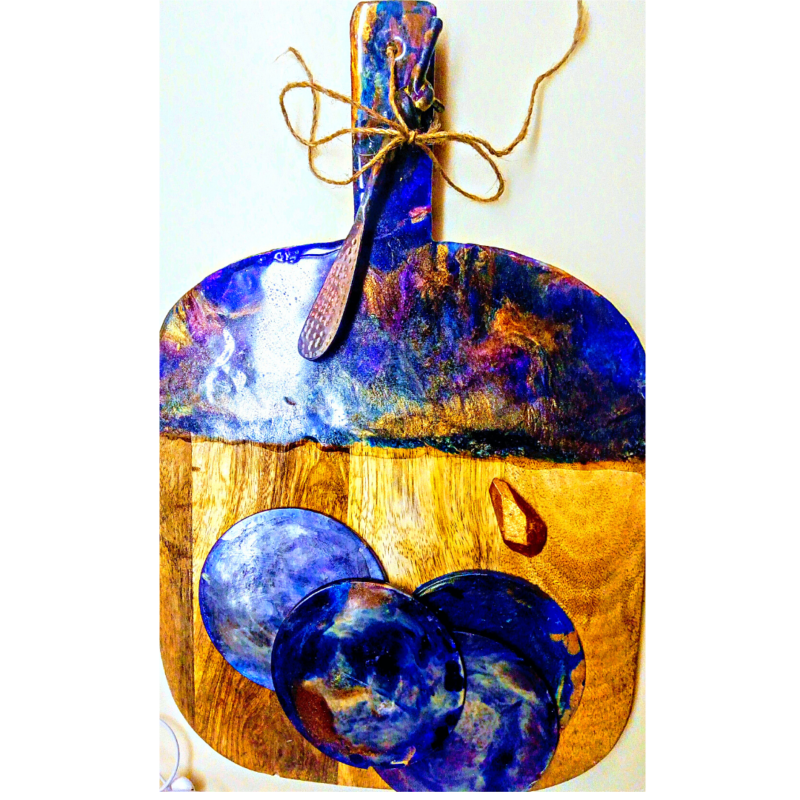
Resin Cheese Board Material List
Here is a list of materials you will need to make wooden resin cheese boards:
- Wooden Serving Board (Choose one you love!)
- Painters’ Tape
- Primer
- Craft Resin Epoxy Resin
- Measuring cups
- Mixing sticks
- Gloves
- Level or Leveling Plate
- Surface Protection
- Glitter
- Colorants (You will want at least one of each type in complimentary colors)
- Finishing Wood Oil
Resin Cheese Board Tutorial
Step 1: Choose Cheese Board
I have provided a link to all the Wooden Cheese boards available on Amazon at the moment. Choose one you like and for more ideas, check out the video tutorials listed below.
Step 2: Tape the Board
Tape your wooden board in all the areas you wish to stay resin-free. This includes the back of your board! For further explanation, and another great tip involving the use of a plastic sandwich baggie, check out the Beginner’s Tutorial listed in the video tutorial section below.
Step 3: Mix the Resin
Follow the manufacturer’s instructions to measure and mix the resin and hardener. Mix thoroughly to ensure an even consistency.
Step 4: Add Colorants
If desired, add colorants to the resin mixture and stir.
Step 5: Pour the Resin
Pour the resin mixture onto the center of the wooden board, spreading it evenly over the surface with a stir stick.
Step 6: Add Embeddables
If desired, sprinkle glitter or other embeddables into the resin mixture.
Step 7: Allow to Cure
Allow the resin to cure for the recommended time, usually 24 to 48 hours, depending on the type of resin used.
Step 8: Peel Tape
Peel off the tape from the areas you did not want to get any resin on. If you have trouble peeling the tape in any areas, heat the tape up with a heat gun or blow dryer for a few seconds. Once warmed up you should have no problem removing the tape!
Step 9: Apply Finishing Oil
If desired, apply a finishing oil or sealant to the wooden board to protect it from moisture.
Resin Cheese Board Video Tutorial
Check out Swiss Cheese Resin Cutting Board (Advanced Technique)
See also, Resin Cutting Board Tutorial (Beginner’s Technique)
Resin Art Project 7: Resin Serving Trays

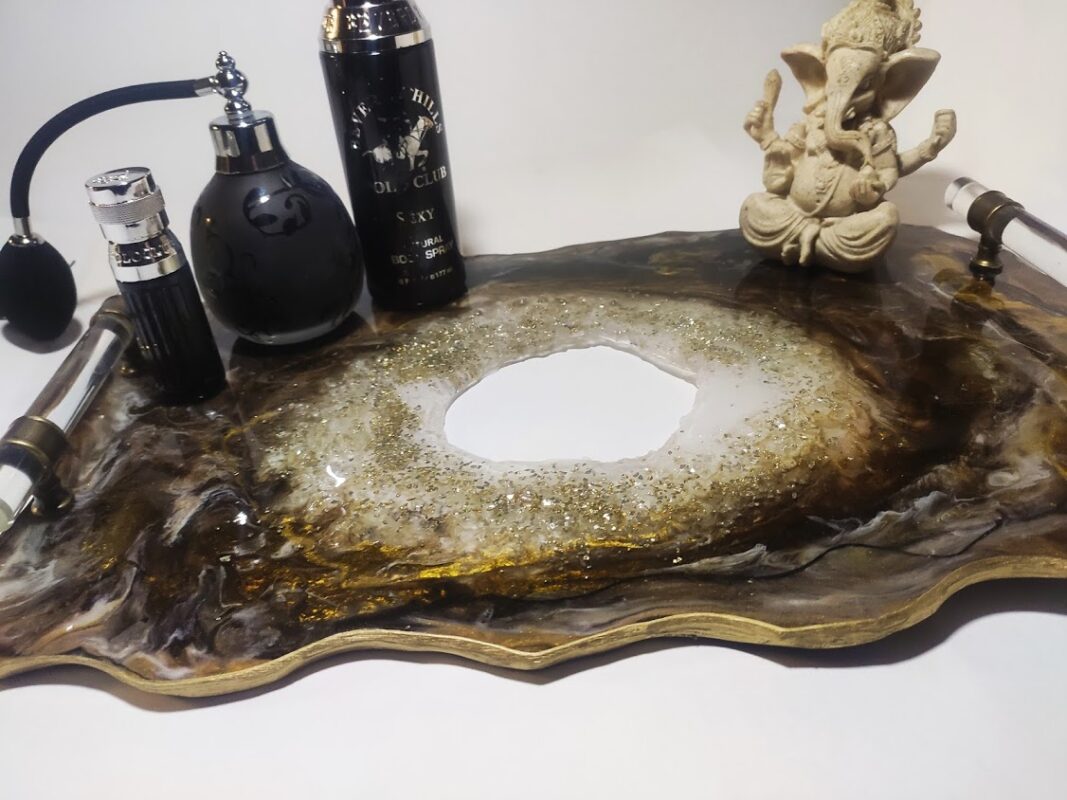
Resin Serving Tray Material List
- Silicone Tray Mold
- Recommended Kit: Resin World 2 Sizes Tray Mold with Handles
- Recommended Kit: Hoolerry 3 Pieces Resin Tray Molds with 6 Gold Handles
- Recommended Kit: ModWgGuo Mold Kit- Irregular Agate Edge and Straight Edge Resin Tray Mold with Handles Included
- More Options
- Handles (if they do not come with the mold kit you select)
- Craft Resin Epoxy Resin
- Measuring cups
- Mixing sticks
- Gloves
- Level or Leveling Plate
- Surface Protection
- Glitter
- Colorants (You will want at least one of each type in complimentary colors)
Resin Serving Tray Tutorial
Step 1: Choose a Resin Serving Tray Mold
Choose a resin tray mold that you like. I have linked to some of my favorite molds and mold kits. The kits are really handy because they include molds and the handles needed to make your resin serving tray. If you do not like any of the styles i the kits, choose a mold you like and choose your own custom handles by following the links provided above!
Step 2: Mix the Resin
Follow the manufacturer’s instructions to measure and mix the resin and hardener. Mix thoroughly to ensure an even consistency.
Step 3: Add Colorants
Separate resin into separate cups. Add colorants and glitter to the resin and stir. Start to think about the order you want to pour each color into your mold.
Step 4: Pour the Resin
Pour you colored resin into the mold. Remember that adding some clear resin creates neat effects.
Step 5: Add Embeddables
If you want, add embeddables. Some embeddables that look neat are quartz crystals or precious stones.
Step 6: Allow to Cure
Allow the resin to cure for the recommended time, usually 24 to 48 hours, depending on the type of resin used.
Step 7: Add Handles (optional)
After the resin has cured for 2-3 hours, place your handles in the desired position. (If you are using a quick cure resin, add your handles a bit sooner.) You want to add the handles one the resin has started to stiffen, but not once it has completely cured. The resin should still be sticky so the handles will stay in place once the piece has fully cured.
Step 8: Demold
After the resin has fully cured, demold your piece and enjoy!
Resin Serving Tray Video Tutorial
Check out Resin Serving or Vanity Tray Tutorial
Also, see Resin Tray or Trivet: Beginners’ Resin Art Tutorial
Another one to check out: Resin Serving Tray- Peacock Colors
Resin Art Project 8: Resin Bookends
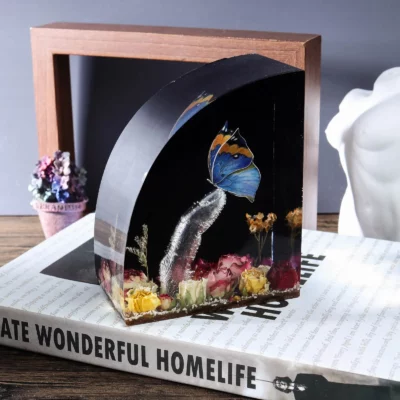
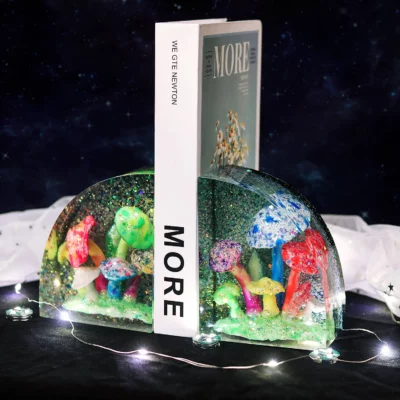
Resin Bookend Material List
Here is a list of materials you will need to make resin bookends:
(Click on each material to purchase the exact product I recommend using for this project.)
- Molds for the bookends (silicone or plastic molds)
- Let’s Resin Epoxy Resin Kit
- Measuring cups
- Mixing sticks
- Gloves
- Level or Leveling Plate
- Surface Protection
- Glitter
- Colorants (You will want at least one of each type in complimentary colors)
Resin Bookend Tutorial
Step 1: Prepare the Molds
Clean and dry the molds, making sure there is no debris or dust that could interfere with the curing process.
Step2: Mix the Resin
Note: I suggest doing this pour in two. So, only mix up enough resin to fill the molds up halfway.
Follow the manufacturer’s instructions to measure and mix the resin and hardener. Mix thoroughly to ensure the resin cures completely. Separate resin into separate cups to add your colorants to.
Step 3: Add Colorants
Add colorants to the resin cups and stir.
Step 4: Pour the Resin
Pour your colored resin into the molds until they are about halfway full. Add any embeddables you want into the mold as well.
Step 5: Let Cure Halfway and Finish Filling Molds
After about 2-3 hours, mix up another batch of resin and color it as you like. Fill the molds up completely.
Note: If you are using a quick cure resin, you do not need to wait as long to pour your second layer of resin into the bookend molds.
Step 6: Let Cure
Allow the resin to cure for the recommended time, usually 24 to 48 hours, depending on the type of resin used.
Resin Art Project 9: Resin Ornaments
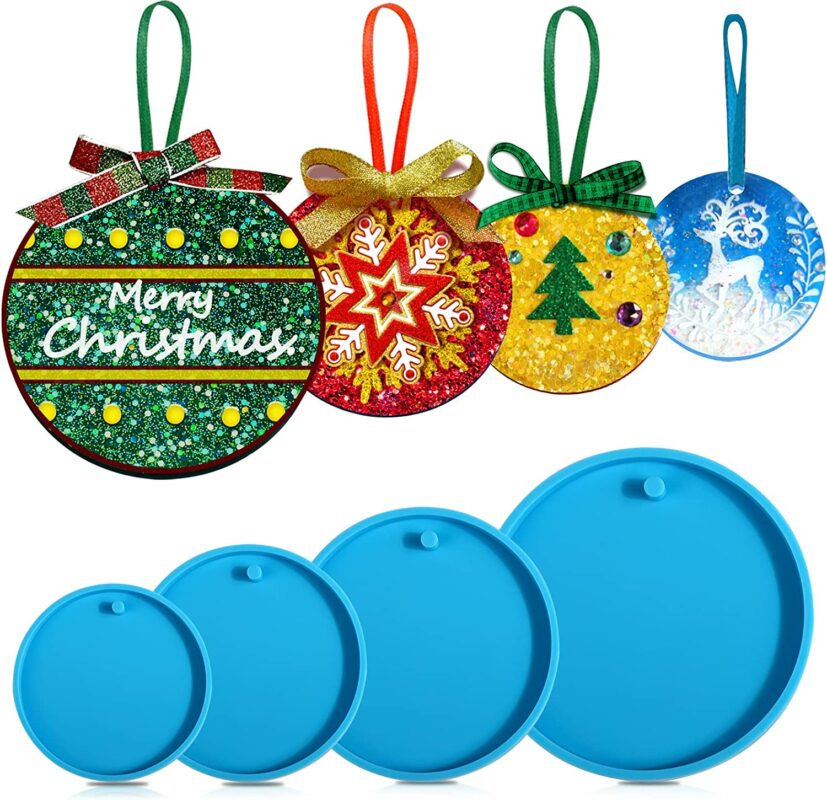

Resin Ornament Material List
Here is a list of materials you will need to make resin ornaments:
- Resin Ornament Molds
- Let’s Resin Epoxy Resin Kit
- Measuring cups
- Mixing sticks
- Gloves
- Level or Leveling Plate
- Surface Protection
- Glitter
- Colorants (You will want at least one of each type in complimentary colors)
- Twine
- Christmas Ribbon
Resin Ornament Tutorial
Step 1: Prepare the Molds
Clean and dry the molds, ensuring no debris or dust could interfere with the curing process.
Step 2: Mix the Resin
Follow the manufacturer’s instructions to measure and mix the resin and hardener. Mix thoroughly to ensure an even consistency. Split resin into separate cups.
Step 3: Add Colorants
Add colorants to each of the resin cups and stir.
Step 4: Pour the Resin
Pour the colored resin into the molds, filling them about two-thirds full.
Step 5: Add Embeddables
If desired, sprinkle glitter or other embeddables into the resin mixture.
Step 6: Allow to Cure
Allow the resin to cure for the recommended time, usually 24 to 48 hours, depending on the type of resin used.
Step 7: Demold
Demold the ornaments.
Step 8: Add Bow and Hanging Material
If desired, tie a little bow at the top of your ornament using the Christmas ribbon linked in the material list. Also optional, add a loop of twine to the top ornament for ease in hanging on the Christmas tree!
Resin Art Project 10: Resin Keychains
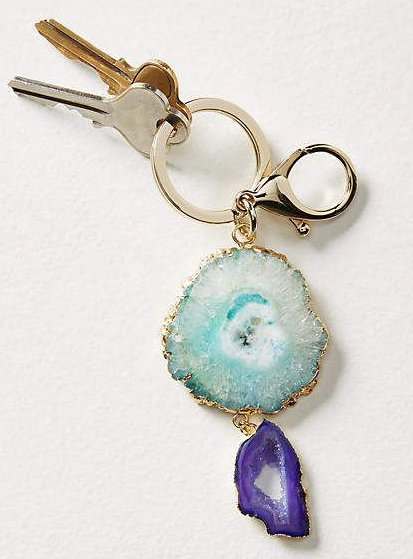
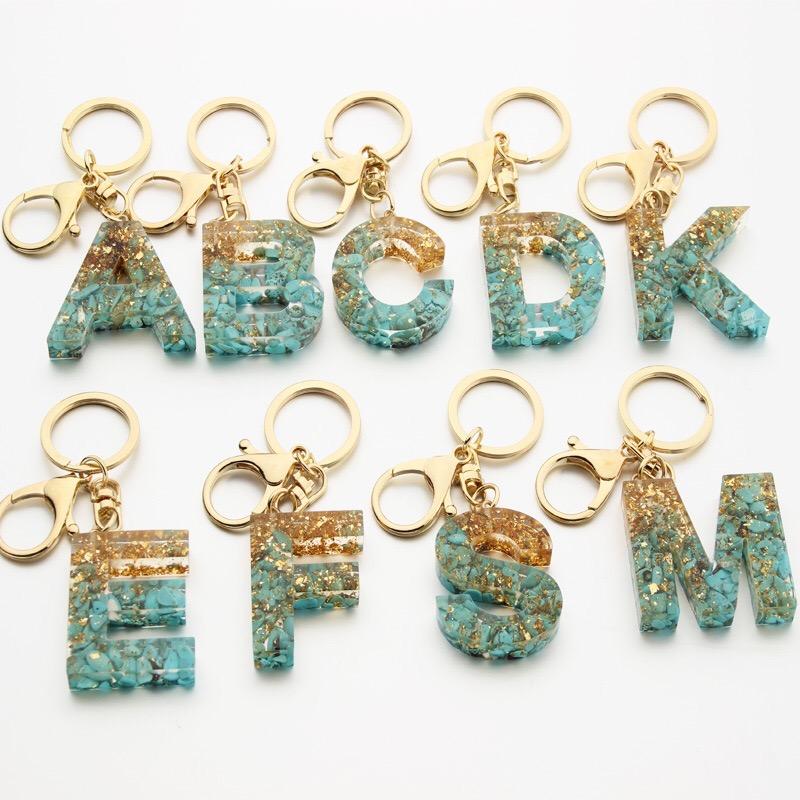
Resin Keychain Material List
Here is a list of materials you will need to make resin keychains:
- Keychain molds (Choose your favorite! Be sure it is silicone.)
- Let’s Resin Epoxy Resin Kit
- Measuring cups
- Mixing sticks
- Gloves
- Gloves
- Level or Leveling Plate
- Surface Protection
- Glitter
- Colorants (You will want at least one of each type in complimentary colors)
- Keyrings with Chain
- Jump Ring Pliers
Resin Keychain Tutorial
Step 1: Prepare the Molds
Clean and dry the molds, making sure there is no debris or dust that could interfere with the curing process.
Step 2: Mix the Resin
Follow the manufacturer’s instructions to measure and mix the resin and hardener. Mix thoroughly to ensure an even consistency.
Step 3: Add Colorants
If desired, add colorants to the resin mixture and stir.
Step 4: Pour the Resin
Pour the resin mixture into the molds, filling them about two-thirds full.
Step 5: Add Embeddables
If desired, sprinkle glitter or other embeddables into the resin mixture.
Step 6: Allow to Cure
Allow the resin to cure for the recommended time, usually 24 to 48 hours, depending on the type of resin used.
Step 7: Add Keyring and Jumprings
Use jump ring pliers or your fingers to attach a keyring or jump ring to the top of the resin keychain.
In conclusion, epoxy resin is a versatile material that can be used to create a wide range of art projects. From coasters to wall art, and everything in between, the possibilities are endless. These 10 tutorials provide a starting point and a glimpse into the vast potential of epoxy resin art. Whether you are a seasoned artist or a beginner, there is something for everyone. So, grab your supplies and let your creativity flow. Have fun and don’t be afraid to experiment and try new things. With a little practice and patience, you’ll be amazed at what you can create with epoxy resin.
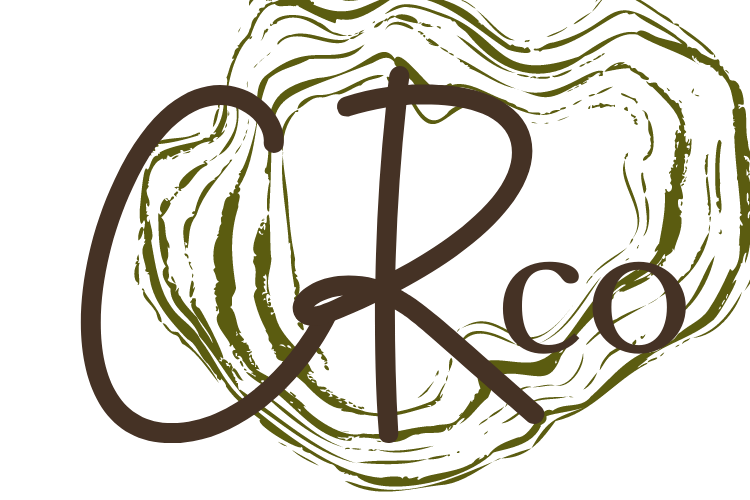
9 Responses
Wow, some seriously stunning artwork here and some great ideas for gifts. I am not that confident yet, but going to a couple of classes that teach you epoxy resin art has really been a lot of fun, and the quality of the goods you can make is second to none.
By Xmas, I hope to have a beautiful collection of gifts made by me for family and friends, and those keyrings at the bottom of the post are something I would love to try.
Michel- Keep practicing and I am sure you’ll have some amazing gifts for your friends and family. Check out some of the tutorials on our blog and a great article for you to read is 5 Tips for Creating Stunning Resin Art: A Beginner’s Guide. Happy Crafting!!
Hi you, it was a delight to read your post. Your post is very creative and inspiring. I love works of art. Epoxy resin is one of these arts that I always wanted to work in this field, but I could not find suitable training for it. So glad I saw your post today. Not only did you comprehensively explain how to make each one, but you also introduced the necessary supplies for each one. Thank you so much.
Liam-So glad you found this post useful. I hope you get around to trying one of these projects. Feel free to come back with any questions you may have.
“I’m so glad I stumbled upon your post on 10 epoxy resin art projects! As a beginner artist, I’ve been wanting to experiment with epoxy resin but didn’t know where to start. Your tutorials are so inspiring and I love the variety of projects you’ve included. This post has definitely sparked my creativity and given me the confidence to try epoxy resin art for myself. Thank you for sharing your expertise and inspiring us to unleash our inner artists!
Tony, so glad you stopped by and so glad you have been inspired! I would love to see what you end up creating so please stop back by after you have tried your first project and let us know if there is anything we can do to help! Happy crafting!
Tony, so glad you stopped by and so glad you have been inspired! I would love to see what you end up creating so please stop back by after you have tried your first project and let us know if there is anything we can do to help! Happy crafting!
Neat looking site. I didn’t know about resin art. But the work looks incredible. Your instructions are easy to follow and beginner friendly. Will have to give this art form a try. I have a lot of empty wall space and these resin art projects have given me lots of ideas. No need to buy expensive paintings or other art forms from dealers and art fairs.
Yes, or you can look through the products we offer in our Resin Art Shop if you are not up to creating something yourself. Thanks so much for stopping by!